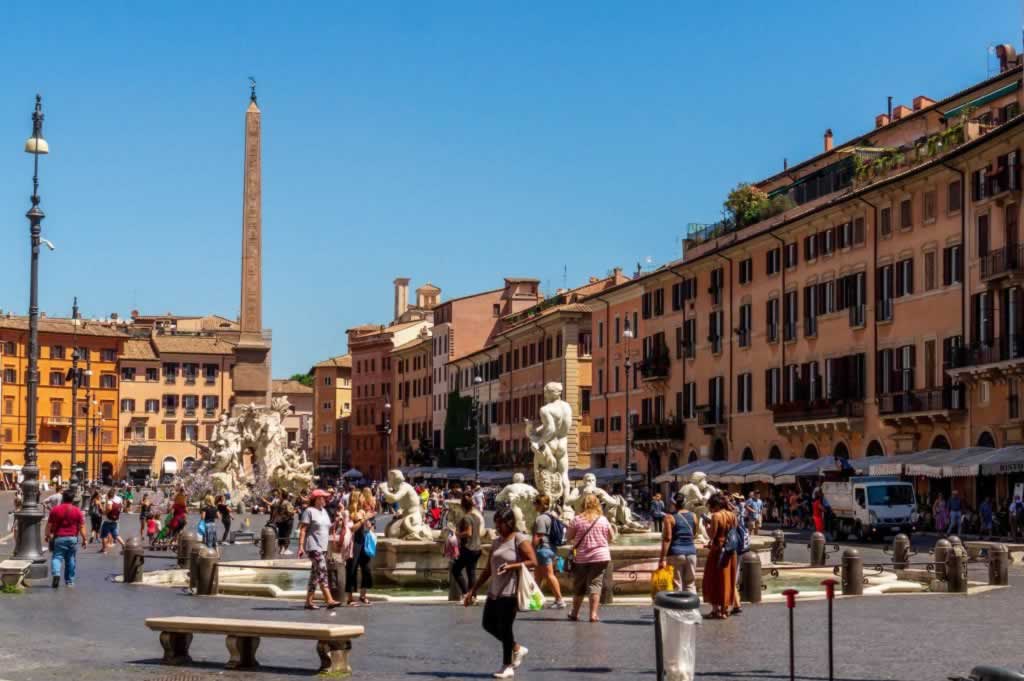Last Updated on: 11th September 2023, 07:34 am
Rome boasts 13 ancient obelisks. Eight of them date back in Ancient Egypt. The other five obelisks were created in Antique Rome.
Main Topics of Obelisco Agonale: Ancient Monument in the Heart of Rome’s Piazza Navona
History of the Obelisco Agonale
The Obelisco Agonale originally stood in the city of Heliopolis in Egypt around 1280 BC. It was commissioned by Pharaoh Ramses II to stand in front of the Temple of Ra. It did for a while, but, as you can obviously see, it ended up by standing in Rome, in the beautiful Navona Square.
You can see the obelisk in the photo below, in the faraway plan.

The four-sided obelisk measures 25.5 m tall and weighs over 230 tonnes. It is covered in hieroglyphics exalting Pharaoh Ramses II.
In 10 BC, the obelisk was brought to Rome on orders from Emperor Augustus and it was placed in the Circus Maximus.
The monolith served as a gnomon – the pointer on a sundial. It cast a shadow on the markers in the circus to track time for Romans. I always loved the creativity and the common sense of Ancient Romans. They knew how to make use of monuments and to repurpose them to serve goals they weren’t actually designed for.
The Obelisk Today
Eventually the obelisk was moved to its current home in Piazza Navona. The piazza was built on the site of the Stadium of Domitian, an ancient Roman stadium used for athletic contests.
Pope Innocent X had the Obelisco Agonale erected on its marble and granite base in 1651. The dove at the top of Obelisco Agonale is Pope Innocent X’s family symbol, as well as the widely recognized symbol of peace.
Today, the 89-foot obelisk proudly stands on top of Fontana dei Quattro Fiumi (Fountain of Four Rivers by architect Bernini), near the other two water features in ;piazza Navona, Fontana del Moro, and Fontana del Nettuno. The square and its monuments are emblematic of the Baroque Roman architecture of the 17th century.
Thousands of tourists pass by the Obelisco Agonale every year, admiring its intricate hieroglyphics and taking in the history of this ancient Egyptian monument that found its home in Rome. The obelisk has withstood thousands of years and still stands as an important relic linking the past to the present.

Visiting the Obelisco Agonale
Piazza Navona is located in the historic center of Rome, within walking distance of the Pantheon and Roman Forum. The piazza is a popular site for tourists to visit. Ask anyone for directions and you’ll find it in no time.
The best time to visit Piazza Navona is in the morning before the crowds arrive. Summer can be very busy, while winter and fall offer a quieter atmosphere.
If you want to take advantage of the golden hour, come late afternoon to take photos of Obelisco Agonale and of the fountains in the square.
Come around sunset to see the fountains illuminated. I can’t remember, though, whether the obelisk is also lit. Nonetheless, this area is beautiful in the evening, as it is full of people trying to find a restaurant for dinner.
To get here, take the metro to Barberini station and walk about 12 minutes. Or take bus lines 70, 81, 87, 116, 492, and 628 which stop right near the piazza.
More to See in the Area
While visiting Piazza Navona, don’t miss the three stunning fountains that also stand in the plaza. They are well-worth to add to any Rome visiting bucket list.
The Church of Sant’ Agnese in Agone right on the piazza has beautiful Baroque architecture. Make sure you check it out.
Nearby landmarks include the Pantheon, Trevi Fountain, Spanish Steps, Roman Forum, and Palazzo Altemps which houses an extensive Roman sculpture collection and my all time favorite, the amazing Ludovisi Battle sarcophagus.
The neighborhood is also full of restaurants, gelato shops, museums, and historic churches.
With its Egyptian obelisk, ornate fountains, and lively atmosphere, Piazza Navona is a must-see when visiting Rome. The Obelisco Agonale is visible from afar, so there’s no doubt you’re going to find it in your Rome itineraries.
Before you go:
The Obelisco Agonale in Piazza Navona is only one of the important landmarks to see in Rome. Read my next article to make sure you pick the right accommodation to cover as many of these landmarks as possible without wasting too much time commuting.
Related articles:
- How Many Days in Rome Is Enough?
- Rome Ciampino Airport: A Complete Guide
- Trastevere: Rome’s Coolest Neighborhood
- Rome Walking Tours Self Guided – Sightseeing without the Crowds
- Crypta Balbi – A Glimpse into the Layered Urban Evolution of Rome
- Castel Sant’ Angelo in Rome – Hadrian’s Tomb, Repurposed
- Ostia Beach (Lido di Ostia) | As Close to Rome as It Gets
- Ostia Antica, Best Day Trip from Rome – Why Visit & How To Do It
- Why Visit the Church of San Luigi dei Francesi in Rome
- Ludovisi Battle Sarcophagus – How To Find This Roman Battle Scene and Why Visit?
- Where to See Caravaggio in Rome: Famous Paintings in Churches
- Where to Stay in Rome: A Guide to Neighborhoods and Accommodations
- The Roman Baths of Caracalla – Location, Tickets & Reasons To Visit
- Baths of Diocletian in Rome – Finest Ancient Roman Architecture
- Â
- Dingli Cliffs: How To Visit Malta’s Highest Point - April 24, 2024
- Blue Grotto Malta - April 23, 2024
- Ramla Beach Gozo, Maybe the Best in Malta - April 9, 2024

